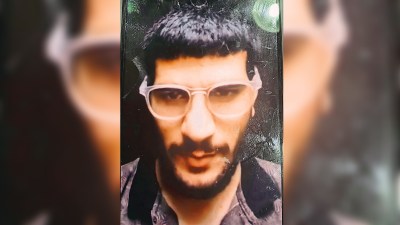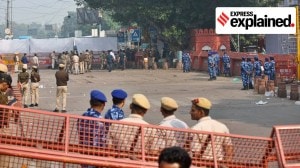Live-in It Up at 50
They came to find new partners for their loneliness,and companions for whom they would not have to fix breakfast. They came looking for friendship,and not the complications of marriage. At a match-making function in Ahmedabad to help single,elderly people find live-in partners,we found changing attitudes to an old institution.
They came to find new partners for their loneliness,and companions for whom they would not have to fix breakfast. They came looking for friendship,and not the complications of marriage. At a match-making function in Ahmedabad to help single,elderly people find live-in partners,we found changing attitudes to an old institution.
As the announcer invited a row of women to climb the stage,Vasant Vyas readied his pen and a folded piece of paper,to note down details of someone who could be his companion at the lonely age of 70. A widower for almost a quarter-century now,Vyas came from Vadodara to Ahmedabad last Sunday with his daughter and son-in-law to a match-making function to help single,elderly people find potential live-in partners.
Of the 300 men and 80 women who initially registered for the Senior Citizen Live-in Relationship Sammellan for people above the age of 50 the first such event in India about 300 ended up attending. Seven couples agreed to take things forward,while many others exchanged numbers and promised to stay in touch.
Shy and polite,Vyas sat in a corner of the last row and paid close attention to the announcer’s introductions. Twenty-one number Rekha Mashiv. Umar 49 years. Caste Lahoma. Divorcee,staying with family. Thank you…. Twenty-two number Hansaben Boswania. Living in Jamnagar. Umar 63,divorcee and staying alone. Thank you…, a voice announced in a steady drawl as each woman stood on the stage for 15 seconds,while their profiles were read out to the aged,lonely hearts sitting in front. The ladies are young, Vyas commented,as a group of women,with numbered red badges pinned to their chests,moved off-stage.
The ladies were also too few,taking up just over a quarter of the seats in the small auditorium where fans whirred above and television crews squeezed themselves into corners. Organiser Natu Patel,who heads the Vina Mulya Amulya Seva (VMAS),had expected this and set strict selection criteria for men; they should have a monthly income of at least Rs 20,000 per month,have the consent of their children and should be capable of paying Rs 1 lakh to their partner if the relationship did not work out. Many met neither the income nor the consent criteria,but few seemed to care,including Patel. The Supreme Court has allowed live-in relationships. So we have come to find ourselves new partners for our loneliness, he announced to noisy applause.
Last year,the Supreme Court had observed in more than one case that live-in relationships are perfectly legal. When two adult people want to live together,what is the offence? Living together is not an offence. It cannot be an offence,” a three-judge bench headed by Chief Justice KG Balakrishnan said. A later observation also laid down how a live-in partner could claim alimony.
Marriage turns the wheels of life in wedding-obsessed India,from television soaps to bridal-wear. But the freedom of two adults to live a life outside the social contract is being slowly conceded,even if it is sometimes accompanied by whispers or raised eyebrows.
Pop culture and movies would have you believe,though,that live-in relationships are for the young and the hip. But at this unique gathering in Ahmedabad,as grey-haired women and men trooped in,there was hardly a sense that they had agreed to be part of a radical experiment in non-conformism,or were raising the banner of revolt against a hoary institution.
Purshottam Vala,an 83-year-old retired auditor from Ahmedabad,came without his family members knowledge,and was looking for a woman who needed support and who would,in return,share his passion,literature. Reba Mukherjee,a 61-year-old tuition teacher from Mumbai,took the train to Ahmedabad in hopes of finding a bachelor her age or older. A regular at her neighbourhood gym,she wore a bright pink salwar-kameez and wore her hair short.
I want a bachelor because I don’t want responsibilities. I don’t want children,but I can adopt one,like I can adopt a man. I want to be free and I want love, she said. A divorcee from Mumbai,who declined to give her name,said she was looking for luxury. “I don’t want a man who expects me to get up in the morning and make him breakfast, she said,adjusting the folds of her black sari.
Revolutionary it was not,but this was a gathering which had shed a few prejudices. A Parsi man from Mumbai said he was open to a Parsi or Gujarati Hindu partner. A Muslim man in a grey kurta had his turn on stage. A wiry Sikh man with a purple turban did not have any specific choices. This event is good. It is caste no bar. Not even religion. That’s why that man is also here, said Vyas,nodding in approval.
Gaurang Jani,who teaches at the sociology department in Gujarat University,saw the meeting as an outcome of spreading liberal values in big cities, though he warned that the situation is starkly different in villages and small towns. Live-in relationships are a social experiment in India,which is organised around structured and formal relationships like marriage. Whether they will fail or succeed will depend on whether social values change as swiftly around them, he said. For that,Jani said,support has to come from within the family. For the elderly who are single,the family is society. If the children support them,that will guarantee them freedom from any stigma, he said.
The organiser of the sammelan,62-year-old Patel,said he saw the benefits of live-in relationships long before progressive court judgements. In the last eight years,he has organised 11 marriage sammellans in various cities,and 34 couples had tied the knot. Three couples called it off because of problems that cropped up in their families. Live-in relationships,he said,were a no-frills way to avoid these issues. He said he has plans to organise the next sammellan in Bhopal in February,with subsequent ones in Delhi,Mumbai,Pune and Kolkata.
Over the years,Patel and his wife have hosted many single,elderly people on weekends,and found them looking either for marriage or live-in partners. Their network made it easy to inform people about this event. Divorce becomes cumbersome at this age, he said. The genesis of his match-making service lay in the changes he saw around him: his peers were fast becoming lonely once they entered old age,and with nuclear families on the rise,many were moving into old-age homes. But even there,they tend to get lonely,and companionship in their own homes is still the best way to cope, said Farsu Kakkad,a trustee of Jeevan Sandhya,an old-age home in Ahmedabad with 183 inmates.
The gathering gave the elderly a second chance,even if it meant being hurtled into an old cycle of desire and courtship,of being measured and found wanting. When a man was introduced as a brick-kiln owner with a monthly income of Rs 3 lakh,Vyas cupped a hand over his mouth and said in a half-whisper,That is a lot of money. Mera pandra hazaar kya karega?
Vyas has been active after retirement. A former senior engineer with a PSU,he lives alone,and takes part in social work with former colleagues. But he does get lonely. He had attended a marriage sammellan a few months earlier to see what it was about,but did not participate. You know,life gets very depressing. When I was in service,it was okay,I had something to do. But it has been 10 years since I retired,and I would sit alone and think and think and think. I am a habitual loner now, he said.
When it was his turn to go on stage,he stood with his hands folded in front,chin slightly up and head turning confidently from left to right. After the announcer had mentioned his particulars,he nodded a thank you to the audience,and strode off the stage. Aah! You are just saying it! he said,closing his eyes and laughing when someone commented he looked younger than his age.
Even as the auditions continued,some couples seemed to have already made their choices,facing the video cameras and telling the world they had met someone they liked and who felt the same. Ami Pandya stood with a shy smile as journalists gathered around her man,a 66-year-old widower from Ahmedabad called Jitendra Brahmbhatt. A little to the side,Pandya’s young daughter stood with hands folded across her chest,smiling broadly.
Brahmbhatt and Pandya were among the seven couples who agreed to take things further. “She is my girlfriend, Brahmbhatt said later on,Life should be good. We like each other. But as of today,we are not living together. We are dating,much like you young people do. If we decide to get married later on,that’s fine too. Like many others,Brahmbhatt too might not have been in favour of live-in relationships once,but experience and age have changed his mind. Remarriage for me is out of the question,because as you grow old,you realise that marriage brings a lot of complications. At this age,I am wary of all that. Live-in is a practical way out, he said.
Once the auditions finished,participants milled around the stage,where two rows of plastic chairs had been arranged so those interested could sit across each other and talk. Many came and sat across the man or woman of their choice,taking five minutes to introduce themselves and say something about their lives,their likes,and their hopes. A fair woman in a bright pink saree seemed particularly popular.
Outside the hall,people stood near the tea counter and chatted,some exchanging phone numbers. Among them were GR Monga and Jagruti. Monga,a 63-year-old divorcee,is the proprietor of a private school in the south Assam town of Silchar,and Jagruti,a mother of two,is from the Saurashtra peninsula in Gujarat. East meets west, said a photographer excitedly. We have promised to keep in touch and see how things happen. I have been divorced for 10 years now and live alone in Silchar. It is okay during the day because the school keeps me busy. It gets lonely and boring in the evenings. My friends have been pushing me to find another partner for many years now. They are right. That’s why I am here, said Monga.
A few metres away,Vyas stood alone near the halls doorway,his hands clutching the piece of paper,in which a row of numbers were written in black ink. Three or four women took my number. They will call 100 percent, he said.
He walked onto the stage and milled about in the crowd,glancing at the couples who were getting to know each other. He seemed undecided about walking up to anyone,and shuffled this way and that. But soon he walked out of the door,checking his cellphone,and came to the campus gate without talking to anyone.
As he stood on the roadside waiting for his son-in-law and daughter to pick him up,a dusky, attractive woman in a parrot-green sari passed by and smiled. He smiled back. They picked up a conversation on the noisy roadside where cars and trucks zoomed past in the late Sunday afternoon sunshine. He took out his pen from his shirt pocket and fiddled with it,only to replace it without using it. All the time,the two stood and talked.
Vyas turned to see a white Chevrolet Beat pulling up behind him,and waved to the young couple inside. He said his goodbyes,and strode towards the car.
He was about to get in when he saw me. Did you get lucky? I asked. Ah! You should not hurry with these things.
It cannot be decided in a day, he said with a laugh.
The courts on living together
In a judgment on October 22,2010,a Supreme Court bench led by Justice Markandey Katju (now retired) held that a long-term live-in relationship between an unmarried couple,who have lived like spouses in the eyes of society,deserved the same legal status given to a formal marriage. It described live-in relationships as an emerging social phenomenon in big urban cities.
The court clarified that a woman abandoned by her live-in companion is eligible to claim maintenance from him,provided both were single and had lived like spouses in the eyes of society for a substantial period of time.
The judgment defined the expression relationships in the nature of marriage in the Protection of Women from Domestic Violence Act,2005. The statute provides that a woman deserted in such a relationship is equally eligible for maintenance as a woman abandoned by her legally-wedded husband.
Indian society is changing,and this change has been reflected and recognised by the Parliament by enacting the Protection of Women from Domestic Violence Act,2005. The Act has taken notice of a new social phenomenon which has emerged in our country,and is sometimes found in big urban cities in India, Justice Katju,who wrote the judgment,said.
In March 2010,the Supreme Court threw its weight behind live-in relationships when it observed that for a man and a woman in love,to live together is part of the right to life,and not a criminal offence.
If two people,man and woman,want to live together,who can oppose them? What is the offence they commit? This happens because of the cultural exchange between people,a special three-judge bench of Chief Justice of India KG Balakrishnan and Justices Deepak Verma and BS Chauhan said.
The court was hearing a batch of petitions filed by actress Khushboo to quash 22 FIRs filed against her by Tamil activist groups and forums for her alleged comments on pre-marital sex in interviews five years ago.






- 01
- 02
- 03
- 04
- 05

























